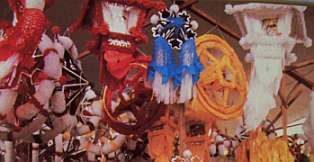|
|
|
|
The Philippines are in southeastern Asia, an archipelago between the Philippine Sea and the South China Sea, east of Vietnam. It consists of more than 7,000 islands and covers an area of about 116,000 square miles. This is the only Asian nation in which Christians predominate. Filipinos say that their celebrations of Christmas are the longest and livliest in the world. Celebrations begin on December 16 with a series of nine pre-dawn Masses (Misa de Gallo) and continue through Three Kings Day on January 6. Misa de Gallo is a Spanish term that means "Mass of the Rooster" since it is celebrated at 4 a.m., at the first cockcrow. The Mass is also known as Simbang Gabi, a Tagalog term meaning "Night Mass." You don't forget about the Mass because the church bells ring out across the countryside calling people to worship. Sometimes the town band traverses the village for an hour before Mass playing a variety of carols to awaken the residents. In small villages, the priest may go from door to door to call the faithful to Mass. Following the Mass there is a great deal of socializing. Food stalls are set up in the church plaza and the surrounding streets. There are long lines to buy such specialties as puto bumbong, a rice cake made with a lavander sticky rice steamed in a special bamboo mold. It is served with a sprinkling of shredded coconut and brown sugar. Suman, another favorite, is a mixture of sticky rice, coconut milk, and sugar wrapped in banana leaves and steamed. The weeks leading up to Christmas are filled with the sight of parols, or star lanterns, decorating the homes, shops, churches, schools, and city streets. These star lanterns are the one element that truly symbolizes the Christmas season for all Filipinos.  Originally small, the parols were carried to light the way of carolers going from house to house. Over the years they have evolved into giant festival lanterns. Lantern competitions are held in major cities just before Christmas. Often they are paraded through the streets to a church or public square where prizes are awarded. Schools also conduct parol compeitions. In some provinces, the Panunuluyan Pageant is held on Christmas Eve before Midnight Mass. A couple dressed in costume as Joseph and Mary go from door to door in a search for shelter. They are accompanied by candle bearers, parol bearers, a brass band, the church choir, and many villagers. The pageant ends at the church just before midnight when the panunuluyan participants assemble near the altar in a Nativity scene. The pageants, festivals, and music used in Christmas celebrations evolved from old tribal customs mixed with Chinese, Spanish, and American traditions. Serenading minstrels known as cumbancheros stroll through the streets during the Christmas holidays. They use musical instruments made from coconut shells, carabao bones, split bamboo, and tin cans. |